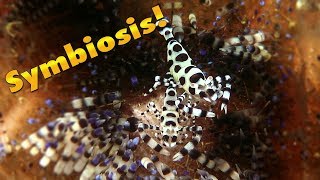(单词翻译:单击)
Fifteen minutes later, with the anemones planted on her new shell, the hermit crab has completed her move.
十五分钟后,寄居蟹把海葵都放到了新壳上,大功告成。
She leaves her old shell for the next hermit crab a bit smaller than herself.
她把旧壳留给下一只比她小点的寄居蟹。
Another crab has a different symbiotic strategy for survival.
另一种蟹有着不同的共生策略。
This decorator crab grows living sponges, hydroids, algae, and tunicates on its body to create camouflage.
这种装饰蟹在其身体上生长活海绵、水生生物、藻类和被囊类动物用作伪装。
When the crab holds still, you will never see it against the similar background.
当它静止不动时,永远不会在相似的背景下发现它。
Only when it moves does it give itself away.
只有当它移动时,它才会暴露自己。
In the ocean, perhaps the animals most commonly involved in symbiotic relationships are shrimp.
在海洋中,最常参与共生关系的动物也许是虾。
Shrimp are found associated with sea cucumbers, sea urchins, sea stars, crinoids, nudibranchs, anemones, coral...you name it. They are everywhere.
人们发现虾与海参、海胆、海星、海百合、裸鳃类动物、海葵、珊瑚等,它们无处不在。
Why? Well, because they make great snacks.
为什么?嗯,因为它们是美味的小食。
Fish love to eat shrimp, so shrimp need to be clever to keep from becoming lunch.
鱼喜欢吃虾,所以虾要聪明一些才不会变成别人的午餐。
Out on the sandy sea floor of the Philippines, a fire urchin slowly makes its way across the bottom, feeding on algae.
在菲律宾的沙质海底,一只火海胆慢慢地穿过海底,进食藻类。
The urchin’s venomous spines protect it from most predators.
海胆的毒刺保护它不受大多数食肉动物的伤害。
On top of the urchin, a pair of Coleman shrimp ride like first class passengers. The shrimp have used their claws to clear the spines off a little spot they call home.
在海胆顶部,一对科尔曼虾像头等舱的乘客。小虾们用爪子把它们小家那块的刺清除掉。
This is a commensal relationship because the shrimp get protection from the urchin, but they don’t offer anything in return to the urchin.
这是一种共栖关系,因为虾得到了对海胆的保护,但它们不给海胆任何回报。
Neither do they harm the urchin, so they are not parasites either.
它们也不会伤害海胆,所以它们也不是寄生虫。

Another shrimp, another free ride. This Spanish Dancer is a large nudibranch--a snail without a shell. It’s about the size of your hand.
又一种虾,又一种搭便车。这位西班牙舞蹈家是一个大型的裸足动物,大小和你手的差不多,裸足动物是一种没有壳的蜗牛。
On its back rides an Imperial shrimp.
它背上骑着一只帝国虾。
The shrimp survives by eating the nudibranch’s poop.
虾吃了海蛞蝓的粪便后存活下来。
It gets a free ride and a meal from the nudibranch, but it gives nothing in return.
它搭海蛞蝓的便车,还从海蛞蝓那获得食物,但不回报任何东西。
Here’s a shrimp with a little more to offer.
这只虾能回报一些东西。
This shrimp lives with a Goby, a small fish, in a burrow in the sand on the sea floor.
这只虾和一种小的鰕虎鱼生活在一起,它们住在海底沙地上的一个洞穴里。
The shrimp works hard to keep the place clean and tidy, constantly arranging the rocks at the entrance and shoveling out the sand that gets inside.
小虾努力工作,让住处干净、整洁,它还不停在入口处放石块,铲出滑进去的沙子。
Why do all this work for the goby? The shrimp needs someone to stand guard.
为什么要为鰕虎鱼做这些事呢?因为小虾需要有人帮它站岗放哨。
While it works, the shrimp keeps one antenna in contact with the goby while the fish keeps its eyes peeled.
虾工作时,它用一个触角与鰕虎鱼接触,鰕虎鱼则观察周围动静。
If the goby moves, the shrimp retreats.
如果鰕虎鱼移动,虾就会退回洞穴。
This is classic mutualistic symbiosis because both animals get something out of their relationship.
这是典型的互惠共生关系,因为两种动物都从它们的关系中得到一些好处。
High above the shrimp’s head is a much larger animal—a whale shark, the size of a bus.
在小虾们头顶的上方是一种超大的动物——鲸鲨,它有公共汽车那么大。
Swimming around it are a few fish called jacks. These fish are using the whale shark as a body guard.
在它周围游动的是一些鲹科鱼类,这些鱼用鲸鲨作保镖。
They know that nothing will dare attack the whale shark—it’s too big.
它们知道没有谁敢攻击鲸鲨,因为它太大了。
So if they hang around, they are safe too.
所以如果在它附近游动,它们也是安全的。
The whale shark eats only plankton and tiny fish, so the jacks are safe from the shark’s humongous appetite.
鲸鲨只吃浮游生物和小鱼,所以鲹科鱼类不用担心会被吞入鲨鱼巨大的胃中。
These are only a handful of examples of the symbiotic relationships in the ocean.
这些只是海洋中共生关系的少数几个例子。
There are thousands of different animals all working together to survive, and it is one of the things that makes the blue world so exciting to explore.
有成千上万种不同的动物一起努力生存,这也是探索蓝色世界令人感到兴奋的原因。


